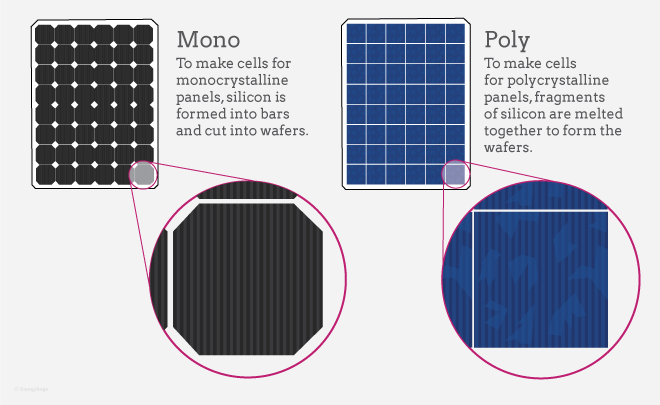Monocrystalline vs Polycrystalline Solar Panels - Choose the right solar panels!
.jpg)
The debate between monocrystalline solar panels and polycrystalline solar panels is a common argument among companies and homeowners before installing a solar energy system. They are both clean ways of generating energy; however, depending on the budget, space, efficiency, and long-term plans, one needs to decide which is the best option.
Introduction to Monocrystalline Solar Panels
Solar panels made from monocrystalline silicon gather their pure light energy manufactured from a single crystal of pure silicon. They are described as highly efficient, longer-lived ones, having a sleek black appearance. These panels fare so well in small areas and are perfect in residential rooftops, where it is also needed to harvest as much power as possible.
Introduction to Polycrystalline Solar Panels
Polycrystalline solar panels can be produced through the fusion of multiple pieces of silicon. They are of a blueish color, and, most often, they are cheaper. These panels would assist well with larger installations that do not need space as such, since budget is a key consideration.
What Is the Difference Between Monocrystalline and Polycrystalline?
-
In contrast, polycrystalline solar panels are manufactured using the process of melting several sub-parts together. They are efficiently designed to be of a sleek black structure.
-
Polycrystalline panels consist of several silicon fragments that have melted into each other. These are blue and generally more affordable.
The main distinction is displayed in the manner of their manufacture, the looks, price, and energy efficiency.
How Do Monocrystalline vs Polycrystalline Solar Panels Perform?
As far as performance goes:
-
Monocrystalline panels also work very well in low light.
-
Polycrystalline panels are slightly less efficient but work well in sunny areas.
The efficiency influences the amount of power your system consumes in the long run.

Monocrystalline vs Polycrystalline Solar Panels - Best Option!
It is best to use monocrystalline panels in case your space is limited and you want to save in the long-term perspective. Polycrystalline panels are truly saving expenses in situations of limited space and scarce funding. The two will reduce the electricity bill, but the amount of production in the long run might differ.
Can I Use Both Monocrystalline and Polycrystalline Panels Together?
You can do it, technically, although it is not a suggested thing to do. Combining panels of different types may have an impact on the system performance as a result of the variation in the voltage and efficiency. There is no point in using both; rather, it is better to use either of the types.
Monocrystalline vs Polycrystalline Solar Panels in Terms of Cost
-
Polycrystalline panels are also economically produced and, hence, affordable for the population.
-
Monocrystalline panels are more expensive but have better returns in the long term, given their efficiency and longevity.
And hence, when front-end costs are everything, use poly. Does it matter? Go with mono.
Monocrystalline vs Polycrystalline Solar Panels - Lifespan & permanence!
The two of these are lifelong, between twenty-five and thirty years.
-
Monocrystalline panels tend to last a little longer and have superior warranties.
-
Polycrystalline panels are also tough and most likely to age poorly in high temperatures.
What Are the Pros and Cons?
-
Monocrystalline Solar Panels
-
Better Longevity: Lit by 25+ year warranties.
-
Space-Saving: Suitable for the rooftops that have little space.
-
Sleek appearance: This is what people admire in contemporary houses.
-
Longer Lifespan: tends to have 25+ year warranties.
They are, however, more costly to finance.
-
Polycrystalline Solar Panels
-
Cheap: They are cheap to afford.
-
Sun: Good in hot, sunny places.
-
Eco-Friendly Process: There is less waste when producing.
However, they occupy larger areas and are less efficient.

Monocrystalline vs Polycrystalline Solar Panels - Which One Should You Select?
That depends on you and what you are trying to achieve:
-
Monocrystalline is also used when there is a desire to achieve better productivity and when spending more money.
-
Select polycrystalline if you're working with a lower budget and have more space available.
Notice: Both yes and no, going solar is a clever choice to have low energy bills and have a low carbon footprint.
FAQ’s
Q1. Better, monocrystalline or polycrystalline?
They have more logical monocrystalline panels, and they utilize a small space.
Q2. Can you combine monocrystalline and polycrystalline solar panels effectively?
Technically, yes, it's not recommended because it may disrupt the regulation of the system.
Q3. Which is more permanent, monocrystalline or polycrystalline?
The monocrystalline panels usually possess a life of longer life period and better warranties.
Q4. Is it worth it to pay more money for monocrystalline panels?
Sure, in case you desire increased efficiency and long-term value.
Q5. What is more suitable in the hot weather?
They both perform pretty well, with monocrystalline performing about the same in heat resistance.
Conclusion
Monocrystalline vs Polycrystalline Solar Panels, both are really good at clean energy, but your prime options are to be chosen depending on the cash flow, real estate situation, and your power demands. Monocrystalline is the way to go when it is efficiency you are after. Polycrystalline will suit you on cost as the primary factor is of no concern. Both of the choices are one step towards a greener future.





